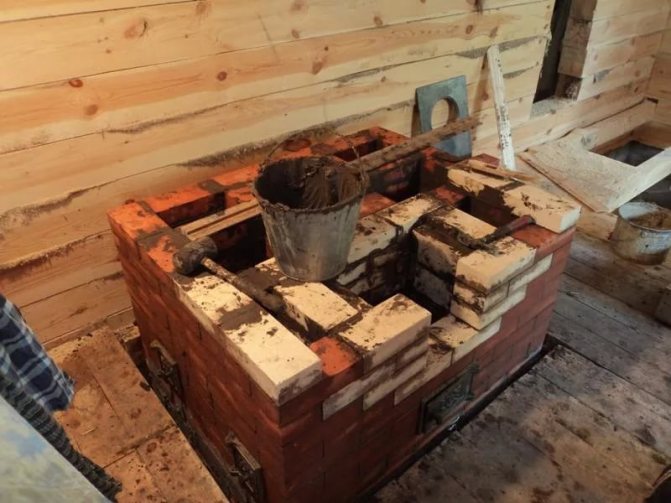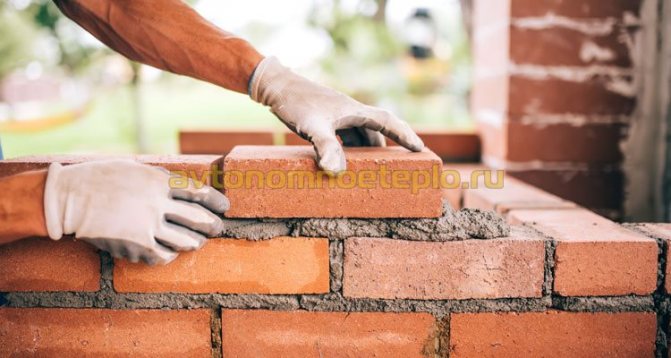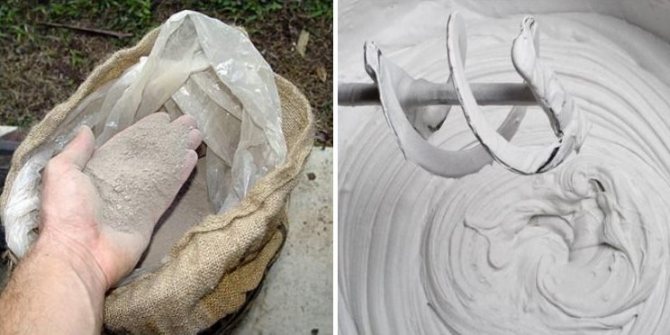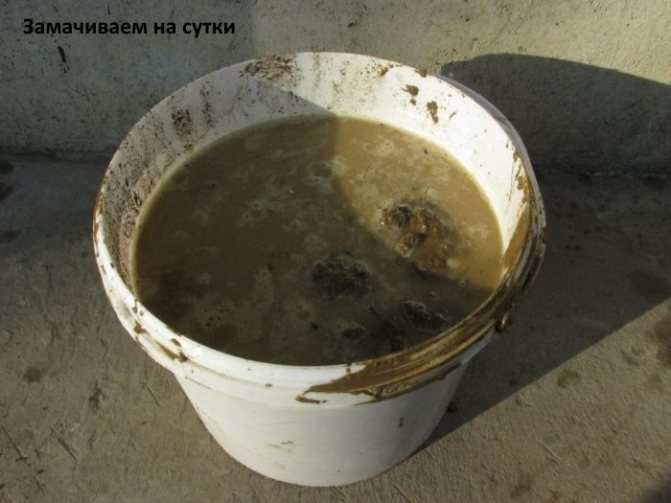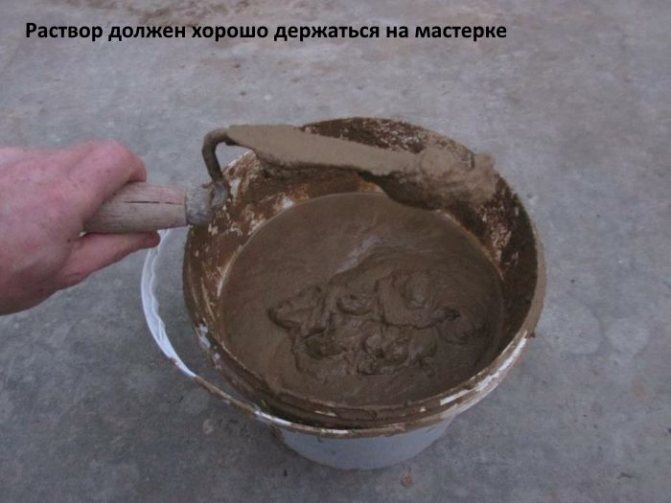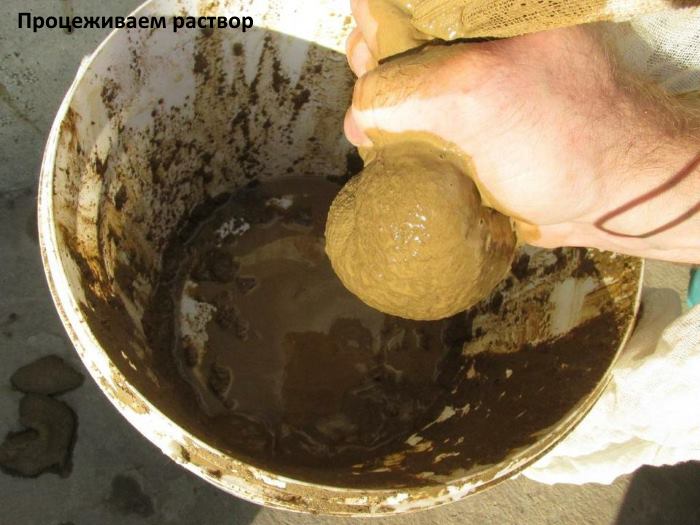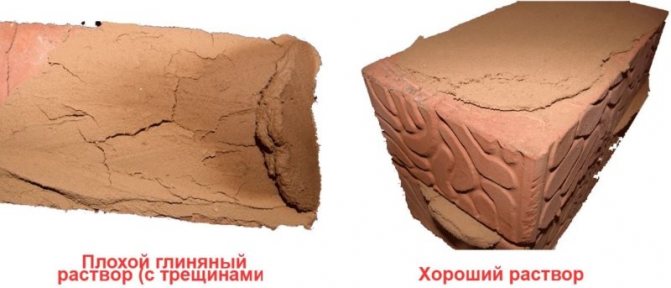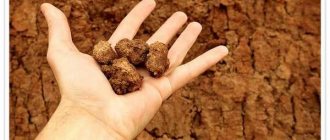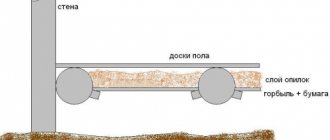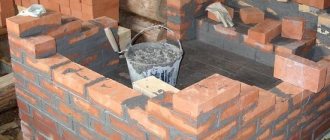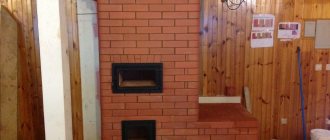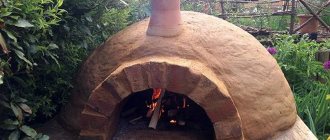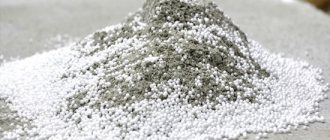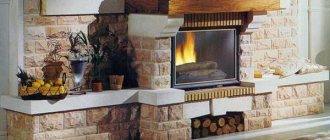Kiln clay
Clay is an irreplaceable material in the preparation of masonry mortar. It owes its demand to unique properties, which consist in the magical transformation of clay into stone after being treated with fire. During the firing process, it acquires the strength inherent in brick, gives excellent adhesion to the structure and withstands the highest temperatures. However, in order to achieve its maximum qualities, it is necessary to prepare a mortar for laying the oven with an optimal ratio of ingredients.
The autonomy and special rustic flavor of wood heating of country cottages compete with gas boilers. You can fold the oven for your home yourself with the right choice of materials. To avoid the appearance of cracks in the housing, brick and masonry mortar should react equally to mechanical and thermal loads, exposure to flue gases. The cement mixture deforms when heated and is not suitable for the construction of heat-resistant structures.
Masonry mortars for the main parts of the oven
1. The furnace part made of refractory bricks (marked with Ш) can withstand heating above 1000 C. The masonry is fastened with a heat-resistant mixture, the main component of which is fireclay clay.
2. The heat storage chamber is heated up to 600 C, the effect of flue gases and acid condensate. Ceramic bricks (solid "oven" M 150) and clay mortar are used for the walls.
3. The chimney is under its own and wind load. The outer pipe is laid out of ordinary bricks on a lime mixture.
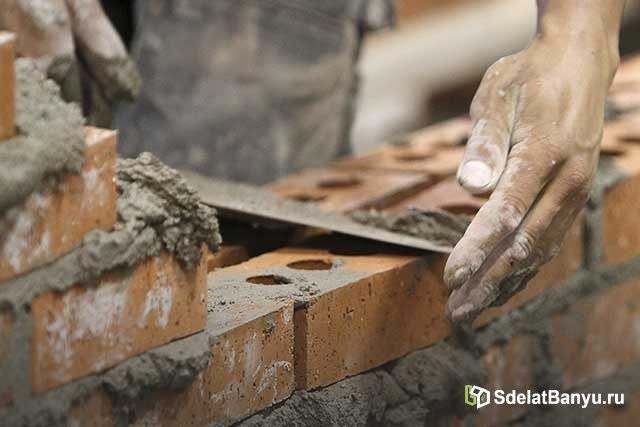
4. In case of deformation, the foundation requires disassembly of the furnace. Therefore, for the base, a strong cement-lime composition and solid brick with good bearing capacity are chosen.
Traditionally, clay mortar is used for laying stoves, since it can withstand temperatures up to 1400 C, has a maximum density, that is, it completely does not let smoke and waste into the room. The microporosity of the material allows the walls of the oven to absorb moisture vapor and "breathe". When heated, clay joints do not expand or crack when cooled. It is possible to disassemble the structure in case of repair work without deformation and waste.
Tricky electricity-saving meter Pays off in 2 months!
Clay is a common mineral on Earth. Outcrops are visible almost everywhere. Despite this, not every clay is suitable for oven work.
The complex of basic qualities is determined by fat content. Clay is oily, medium-fat and lean.
- Oily ˗ plastic, but when dry it cracks and gives strong shrinkage. This leads to deformation and destruction of the structure.
- Medium fat clay is the best option. She has good adhesive properties, strong, heat-resistant, hygroscopic. When dry, it gives a moderate sediment, does not crack.
- Skinny clay has low adhesive properties. It is dry, cracks quickly, the masonry crumbles.


Finding good clay is a great success. Good seams occur at a depth of 5 meters. The surface ones are heavily contaminated with humus, they have a high content of sand impurities. It is loamy, skinny soil. She's not good for the job.
There is a clay formation under the loam layer. The thicker the layer, the better. The lower layers are the fattest clay, but it is also not clean. It is better to take from the middle layers with the lowest content of organic matter and impurities.
Types of clay solutions for stoves and fireplaces
When laying the stove, depending on the temperature regime of the zone being built, several types of mortar are used:
- 1200-1300 С - clay-fireclay and cement-fireclay;
- 1100 С - clay-sand mixture;
- 450-500 С - lime-sand;
- 220-250 С - cement-lime;
- range of atmospheric temperatures (furnace foundation) - cement-sand mixture.
Of the listed masonry mortars, clay or chamotte made from it are included in three mixtures: clay-sand, clay-chamotte and cement-chamotte).
Consider these important components of masonry kiln mixes.
Sauna stove solution
For solutions used in the construction of a brick oven in a bath, the following components are needed:
- cement - the ratio of cement to sand 1:3;
- calcareous - the ratio of sand to lime 2:1;
- lime-cement - lime, sand, cement - 2:1:6-16.
These types of mortar are suitable for arranging the foundation, chimney and other zones; for laying the combustion zone, you will need a mixture of clay and chamotte. The oven is plastered with the following compositions:
- lime, sand, asbestos, gypsum;
- clay, asbestos, sand;
- clay, sand, cement, asbestos.
Reference. To place a summer stove in the courtyard of the cottage, a mixture of refractory clay and sand or from heat-resistant cement, ordinary cement and mortar is used for barbecue.
It is recommended to make a mortar for building a stove on the street based on cement, especially at high humidity. Sand to cement ratio 3 to 1.
Checking the quality of the solution
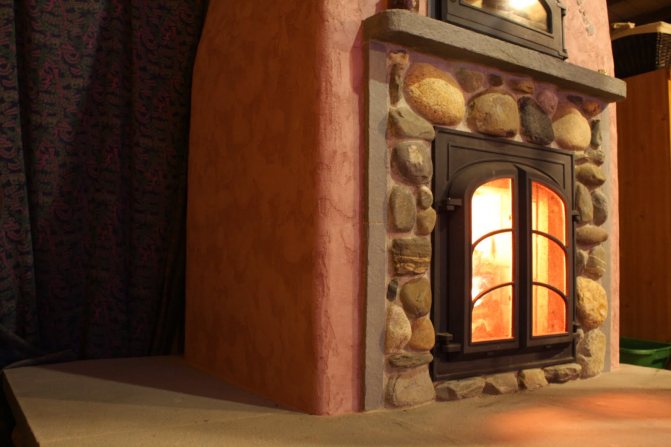

The first test is carried out before preparing the clay for the brickwork. In order for the solution to come out of high quality, you need to accurately identify the fat content of the clay. It will depend on this, what additional components are required.
How greasy oven clay is revealed as follows:
- A small amount of clay - about 1 kg - is thoroughly cleaned using one of the methods described and soaked for several days.
- The resulting mass is divided into five identical parts. Nothing is added to the first, the second is mixed with 25 percent sifted sand, the third with 50 percent, the fourth with 75 percent and the fifth with 100 percent.
- Each of the parts is kneaded separately. If necessary, add a little water until a pasty texture is achieved. You can determine the readiness of the solution with your hands. If it does not stick, the mixture is considered ready.
- The resulting material is checked for ductility. Each of the five particles is rolled into a small ball and flattened into a cake. All the resulting samples are marked with labels, which indicate the proportions of sand, and sent to dry. It will take 2-3 days for the fragments to dry.
- The resulting samples are tested. The cake should not be cracked or shattered when compressed. If you drop it on the floor, it should remain intact. Based on the results of such testing, the correct proportion of sand and clay components is revealed.
You can test for fat content and plasticity in another way. Roll into balls about 3 cm in diameter, place each between two carefully rounded boards. Gently, smoothly press on the upper one, check the condition of the ball. If it cracks immediately, the composition lacks fat content. If cracks occur at half compression, the mixture is too greasy. With the correct proportion of the components, most of the specimen will flatten but not collapse.
Correctly formulated mortar does not crack immediately after application
Additionally, kiln clay is tested before use. Better to redo the mortar than waste time building a stove that will crumble. To check, the composition is scooped up by hand and rubbed with fingers. A good quality binder should be slippery and oily. Experienced stove-makers detect the readiness of the composition by ear when mixing.
A correctly made mixture "whispers" - makes a kind of rustling sound, and lags behind the shovel. You can also dip the trowel into the mixture, pull it out, and then turn it over. If a thick layer sticks, the composition is too oily, it must be diluted with sand.If the layer of solution falls off, there is an excess of sand, you need to add pure clay.
The main indicator is fat content. Distinguish between oily and skinny clay. The first, when dried, significantly decreases in volume and cracks, and the second crumbles.
Clay can be oily and skinny
Immediately, we note that there is no strictly defined ratio of sand and clay to obtain a good solution. The proportions are determined experimentally, by selection depending on the fat content of the breed.
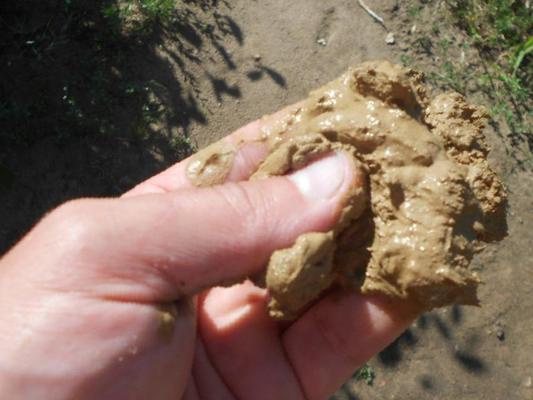

You can determine the fat content of clay rock in the following way. Roll up the rope of clay, assuming a thickness of 10-15 mm and a length of 15-20 cm. Wrap them in a wooden form with a diameter of 50 mm. If the clay is oily, then the tourniquet is stretched gradually, without cracking. Normal provides a smooth stretch of the rope and breaks, reaching a thickness of 15–20% of the original diameter.
Fireplace mortar
One of the most popular recipes for oven masonry mix is a mix that uses sand and clay in a one-to-one ratio. If the clay is too oily, then you need to take not one part of the sand, but two. The finished mixture should have a fairly thick consistency, like sour cream.
It is recommended to check the prepared mixture for quality, for which you need to connect two bricks with it, let them stand for about 5 minutes and try to lift the structure by the brick located on top. If the composition turned out to be of sufficient quality, then two connected bricks can be lifted several times, and they will not fall apart.
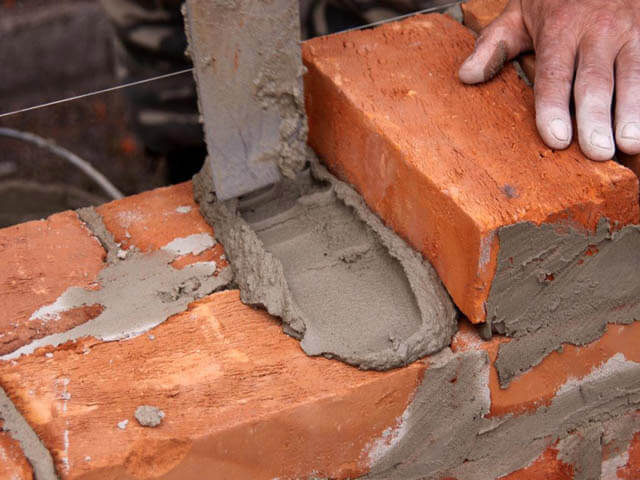

The only thing for which such a composition is not suitable is the laying of a section of the chimney located above the roof, since it requires resistance to moisture. For its arrangement, it is better to take a mixture of three parts of sand and one part of lime dough. You can also use a composition of one part quicklime and three parts plain water.
Clay components of mortars for brick heaters
Fireclay refractory kaolin clay is best suited for masonry ovens
The clay composition differs depending on the added components:
- clay-sandy;
- clay-cement;
- clay-limestone.
Stove makers usually choose the first option. Fractional proportions depend on which clay to use for the oven. If it is oily, the ratio of sand will be 2: 1, if it is medium fat - 1: 1. Also, with good quality clay, you can do without additives.
The strength, reliability and pleasant appearance of stoves and fireplaces largely depend on the quality of the masonry mortar with which they are laid. If some component is not enough or too much, the seams will crack. As a result, smoke from the stove will begin to pass into the room, and fuel costs will increase, since due to excess air supply, it burns faster. Or you can not waste time calculating the proportions, but buy a ready-made composition.
We offer you to familiarize yourself with: Project of a flat roof bath The roof of the bathhouse - basic recommendations for the selection of the type and instructions for building (90 photos)
Masonry mixture for fireplaces and stoves consists of a binder, aggregate and water. If there is only one knitting element in it, then it is considered simple, if two, then complex. The main characteristics are strength and ductility. At the same time, according to plasticity, they are divided into 3 types: skinny, normal, fat.
Clay is a sedimentary rock of fine-grained structure, the forming substance of which is kaolinite, consisting of a mixture of silicon oxides (47%), aluminum (39%) with water (14%). The name kaolin comes from the Chinese area of Kaolin, where such white clay was first discovered. In the presence of iron ions of various valences in kaolin clay, the color of this material can be different - yellow, red, brown, blue, green, but this has little effect on the physical properties.
Clay pit and a clay sample of plastic consistency
Chamotte is a powder obtained by crushing pieces of clay that have sintered during high-temperature firing and have lost molecularly bound water. The size of the chamotte crumb fractions after crushing or grinding is from 0.2 to 2.5 mm. Sifting chamotte powder allows you to separate fractions by size, after which finely ground powder is often called chamotte clay, and coarse - chamotte sand, but the chemical composition and properties of these materials are identical - high heat resistance and low water absorption.
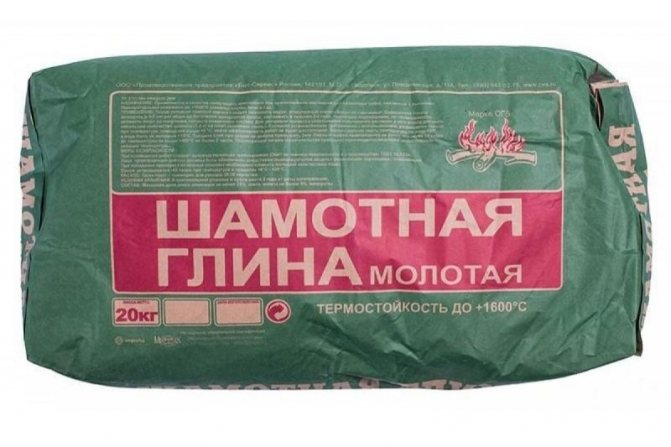

Fireclay filler of industrial production and packaging
The degree of clay sintering depends on the value (or) and duration of high-temperature exposure, which determines the division of chamotte into:
- low-burned - firing temperature 600-900 C, water absorption up to 25%;
- high-burned - for ordinary firing at 1300 C and water absorption is less than 5%, for special-quality ones - at 1500 C with water absorption of less than 2%.
Ready mixes
On sale there is a wide range of dry compounds used in the construction of stoves and fireplaces. Among them are products of domestic, Chinese and European manufacturers.
- Borovichi
The company supplies two types of kiln mixtures. One of them is intended for chimneys, and the other, fireproof, for laying walls and combustion chambers. To improve adhesion, experienced stove-makers recommend adding clay diluted to a liquid state, the so-called clay pulp, to the solution.
- SCANEX
The St. Petersburg production company produces dry mixes for fireclay bricks under the TERM TK trademark and for ceramic bricks - TERM SA. The first has a clay-silicate composition, characterized by refractory properties, therefore it is used when laying fireboxes. The basis of the second mixture used in the construction of external stove and fireplace walls is cement and clay. In addition, the SKANDEX range of products includes a plaster mixture intended for application to the outer surface of fireplace and stove walls. Its name is TERM AL.
- MC-BAUCHEMIE RUSSIA
A joint Russian-German manufacturing company produces dry mixes under the general name - PLITONIT SUPERKAMIN. It:
- THERMOKLADKA - used for external walls;
- REFRACTORY - designed for heat-resistant bricks;
- THERMAL GLUE - used for decorative cladding with ceramic and stone finishing materials.
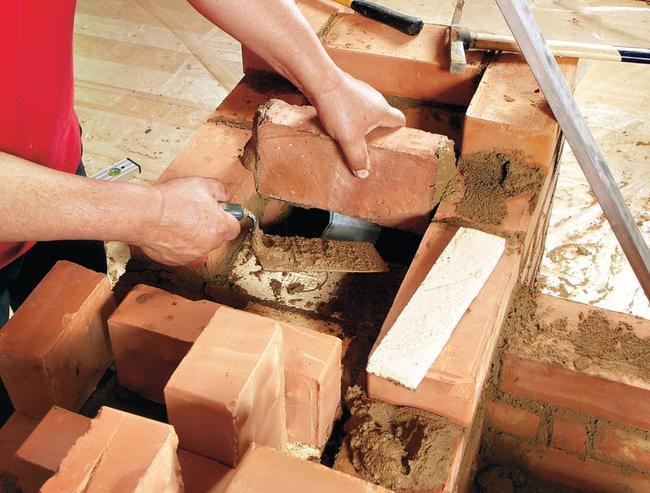

- VETONIT
It is considered the most popular brand among dry mixes produced by foreign manufacturers. By purpose, the material is divided into three types:
- SVL - for chimneys and external enclosures of stoves;
- TM - for combustion chambers and walls in contact with an open flame;
- TV - for casting elements and assemblies operated at high temperatures (1200-1300 degrees Celsius).
Each region has its own manufacturers of dry building mixtures, including those intended for laying fireplaces and stoves. When choosing a material, you should carefully read the instructions on the package, which indicate the composition, consumption, the approximate amount of water required to make the solution, and the conditions for its use.
Methods for removing impurities
The kiln solution requires clean sand. To separate it from impurities, it must first be sieved and then washed. For sifting, a fine-mesh sieve with a mesh size of 1.5 mm is used. Next, the sand is washed like this: a sacking with a sagging is pulled onto the holder (a kind of net should be obtained), into which the sand mixture is placed.
The clay is stirred with water and left to soak
To remove impurities from the clay, it is washed. Crushed, placed in the upper part of an oblong container (for example, an old trough or bath). Place the container at an inclination of 4–8 °. Water is poured into the lower part so that it is at the top and does not touch the clay. Clay is washed with a small spatula or iron scoop.
The sand is sieved through a fine mesh sieve
If you bought a packaged dry clay, you need to soak it. The process of saturating clay with water is quite simple. For work, a wide and deep container is taken, dry clay is poured to a level of 10–20 cm, leveled and water is added. The amount of water - so that everything is completely covered. A day later, it is thoroughly mixed with a shovel, if necessary, liquid is added and again left for the same period. When everything turns into a paste, we can assume that the clay is ready. This is repeated several times until all the required amount is soaked.
The first step is to remove impurities from the natural clay stored for oven laying. There are different ways to do this.
Dry punching
You can wipe the clay through a sieve dry or soaked
The most primitive way. Use your hands to select everything that is superfluous - grass, pebbles, debris, grind large lumps. After that, the plastic material needs to be rubbed through a metal sieve with cells of about 3 mm.
The method can be made slightly less laborious by drying the clay. To do this, clay lumps are laid out on a wooden canvas and dried in the sun. In winter, this is done in the cold, laying it under a canopy so that it does not get covered with snow. With a small amount of material, they are placed indoors, on a heated stove or on a heating radiator. The drying speed depends on the size of the lumps: the smaller they are, the sooner they dry.
Pour the dried clay into a box with thick walls and grind with a rammer. After grinding, clay dust is sieved through a fine mesh sieve to remove various inclusions from it: pebbles, chips, and other debris.
"Dry punching" is a rather laborious task, therefore it is more expedient to soak the clay after manual cleaning for 2-3 days.
- Place the material in a large basin in 12-15 cm layers, wetting abundantly.
- Pour in water at an approximate ratio of one to four to the clay.
- When the mass is soft, mix with a concrete mixer or other means.
- Wipe through the wire mesh 2–2.5 mm.
The bottom layer - sand and stones - is not suitable for bonding bricks
There is also an older way of torturing:
- Several holes are drilled vertically in a wooden container with a small distance between them.
- Each of them, before filling the tub with a liquid clay mass, is muffled with a wooden stopper.
- Grains of sand and a variety of small stones precipitate first due to their greater weight.
- Subsequently, after settling, clay particles settle to the bottom.
- The upper layer of water gradually becomes lighter, but you need to wait until the liquid becomes transparent. As soon as the border of the clarified moisture drops slightly below the first hole from the top, remove the plug. The settled water flows out of the container.
- After the appearance of the next level of settled liquid, take out the next plug.
This process is repeated until all clarified water is completely drained. To speed up the precipitation after loading the solution into the tub, you will need to add bitter Epsom salts - about one pinch per bucket. If there is no wooden barrel at hand, it can be successfully replaced by a metal container suitable in height and volume. The principle of operation is the same with one difference - first, short lengths of pipes are soldered into the holes, plugs are installed in them.
https://youtu.be/yiKghBfhxBM
When all the settled liquid is drained, the liquid clay is transferred to a wide box and left in the sun to evaporate excess moisture. After the dried material ceases to be fluid, stir it periodically with a shovel. As soon as the mass becomes similar in texture to thick dough and stops sticking to the palms, it is covered with polyethylene or oilcloth and stored until the start of the oven work.
Preparing clay for mortar
To make a clay refractory mortar for masonry ovens, you must first sift the clay through a 3 mm sieve. Also, the material should be rinsed out using a fairly old but still quite effective technique.
Flushing is performed as follows:
- The oblong container is installed at an angle and clay is poured into its upper part. The lower part of the container is filled with water so that it does not come into contact with clay.
- The water is guided in waves towards the clay using a suitable tool. The washed clay is slowly washed into the water. A sieve is used to separate clean clay from water.
- The washed clay is laid in layers up to 20 cm thick, each of which is filled with clean water. After a day, all this mass must be thoroughly mixed, add clay if necessary and leave for another day.
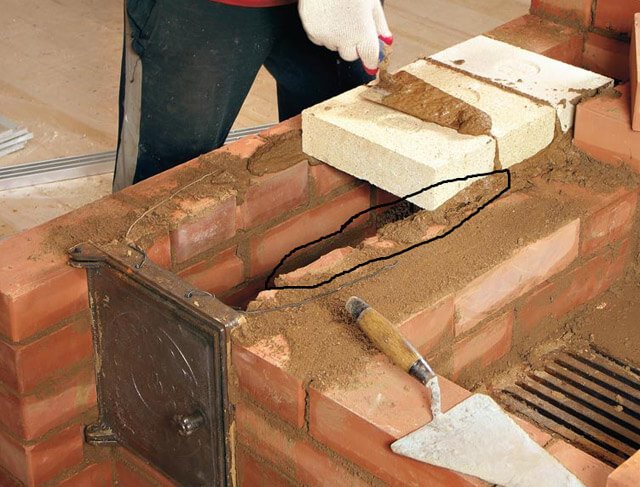

Clay purified using this technology is quite suitable for creating an oven solution.
Clay solution and technology for its preparation
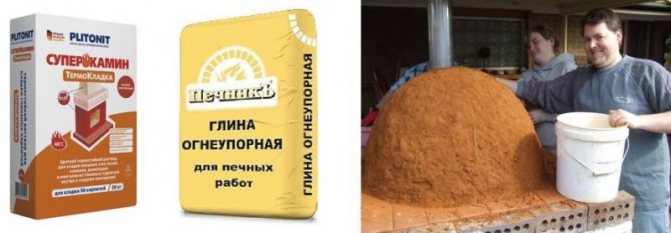

For the construction of the foundation and the chimney, it is recommended to use a composition based on lime and cement.
A special dough made by mixing quicklime and water in a 3: 1 ratio. Sifted sand is added to the finished dough through a fine mesh sieve in a ratio of 3: 1 - for 3 volumes of sand 1 volume of dough. The finished mass is diluted with water until a thick mass is obtained.
A lime-based mixture for laying a kiln turns out to be quite plastic and durable.
The fat content of the lime composition is determined by the amount of sand. For an excessively fat mixture, 5 volumes of the sand component are required, for a normal one - no more than 3 volumes.
Strength and water resistance can be increased by adding cement. To prepare such a composition, it is necessary to use components in the following proportions (parts):
- Cement - 1;
- Sand - 10;
- Lime dough - 2.
The preparation of the solution has the following sequence of actions: cement and sand components are combined in a separate container. The finished lime-based dough is diluted with purified water until a thick consistency is obtained. Bulk components are introduced into the diluted dough and mixed. To increase the viscosity, the composition is diluted with water.
The main characteristic parameter of this material is its fat content, which combines the degree of plasticity, strength, water resistance, as well as adhesion before and after curing.
In nature, clay is of three types - lean, medium fat and oily, there are no clear boundaries between them.
The belonging of a material to one of the types is determined by simple mechanical manipulations, the most accurate of which is performed as follows.
About half a kilogram of clay is kneaded with water until a homogeneous pasty consistency, after which a ball with a diameter of about 5 cm is formed from the resulting mass.
The ball is placed between two pieces of glass, which are slowly squeezed, observing the formation of cracks in the clay:
- the destruction of the ball at the beginning of squeezing indicates a low fat content - thin clay;
- the appearance of thin cracks after reducing the diameter of the sample by 1/3 of the initial value indicates that the clay is of normal fat content;
- if cracks appeared only when the ball was squeezed to half the diameter - a mass of high fat content.
We offer you to familiarize yourself with: How to overlay a stove in a bath, a diagram of a brick lining of a stove in a bath (13 photos)


Determination of the fat content of clay by squeezing: on the left - fat, on the right - normal.
The main factor affecting the fat content of clay is the percentage by weight of sand in it:
- 15 to 30% are skinny;
- from 5 to 15% - medium fat;
- up to 5% - fatty.
When performing furnace work, different solutions are prepared and for different purposes:
- installation of the foundation;
- oven masonry;
- plastering and facing work.
For these purposes, solutions are used:
- clay;
- lime-clay;
- sand-cement;
- lime.
The stoves are placed on a clay mortar, adding a little salt or cement for strength. Many people use only clay with water, no additives. To facilitate the mixing of the solution, some stove-makers make wooden flooring from boards with low sides. The wide working area of mixing allows for better preparation of the solution.
The stoves are placed on a clay-sand mortar
First you need to determine how much material you need. The calculation is as follows: when laying 50 pieces of bricks flat with a seam thickness of 3-5 mm, about 20 liters of masonry mixture will be required (increase by 15-20% if we are building a Russian stove).
Clay mortar is used for the main structure of the kiln, it can also be used for cladding. Consists of clay, water. Sometimes filler is added: sawdust, shavings, construction sand. The clay mixture is prepared in the following proportion: 1 part of filler is added to 2 parts of clay. More often than others, clay-sand mortar is used for laying the furnace.
The components are mixed into a homogeneous mass until a creamy state. The masonry mass should come off the shovel well and leave no marks. Also, separable water should not appear on the surface - if this happens, you need to add sand. To give greater strength, salt is added to the solution: 100–250 grams per bucket of solution. Less commonly, cement is used - 750 grams per bucket.
How to prepare a mortar for laying stoves is demonstrated in the video material. At the same time, you will see the consistency to which you need to soak the clay.
Sand-cement mortar is used to level the surface irregularities and lining the furnace (tile, mosaic, stone). Cement mortar for the kiln is used for sealing joints, when laying the foundation. It is prepared as follows: the required amount of building sand and cement is measured, mixed well, poured with water to the desired consistency - such a state when it is sufficiently mobile and squeezed out of the seam without much pressure. The proportions of materials depend on the brand of cement composition, most often 1: 2.
Lime is used as a mortar for plastering ovens, for laying foundations and pipes. Cooking it is fundamentally different. First, lime is slaked and kept in a special pit for about a week. After that, a solution is prepared with sand. The C ratio depends on the fat content of the lime (usually 1: 2 or 1: 3).
For plastering the furnace, lime-clay mortars are used with the addition of asbestos to give greater strength. The proportions of the solutions are as follows:
- clay-lime dough-sand-asbestos 1: 1: 2: 0.1;
- clay-sand-cement-asbestos in the same ratio;
- gypsum-sand-lime dough-asbestos 1: 1: 2: 0.2.
The cooking technology consists in combining all dry components and adding clay, gypsum or milk of lime diluted with water. Then the components are mixed until smooth.


There is a refractory (chamotte) mortar for laying the core of furnaces. For its preparation, chamotte and refractory clay are mixed in a 1: 1 ratio, then water (one fourth of the clay mass) is added and mixed well.
This is what a good solution looks like on fireclay brick
It is necessary to monitor the quality of the solution. After all, only a sufficiently plastic composition is able to ensure good adhesion of the oven masonry and the tightness of the seams.
Clay is one of the best options for laying a brick oven. But you should not use it for chimneys and foundations, as it collapses due to high humidity. For manufacturing, you will need fine sand (up to 1 mm) and good quality clay. The sand must first be sieved through a sieve to remove debris and small stones.
The maximum temperature that the clay mortar can withstand is 1000 ° C. Moreover, its volume during heating changes in the same way as a brick. Therefore, the masonry remains intact and strong.Compared to others, the consumption of the clay mixture is higher. So, for laying hundreds of bricks, you will need 2 buckets of clay and one and a half sand. Consumption can be reduced if the composition is passed through a sieve, and the seams are made thinner and use a building material that is even without chips.
It is recommended to pre-soak the clay in two days, then it will become more plastic. To make the composition as thick as sour cream in consistency, the clay is passed through a sieve, in the same way the sand. After mixing with the desired ratio of components, it is sieved again. Then it will turn out to be as homogeneous and high quality as possible.
Guide: how to check quality
To find out the quality of clay and whether it is suitable for laying fireplaces and stoves, you should make several solutions with different proportions, or rather, 5 mixtures consisting of the following components:
- clay without any additives;
- the same ratio of clay and sand;
- clay and 10% fine sand, as well as 25 and 75% sand.
Each of the five compositions is thoroughly mixed dry, and then water is poured. It is added until the mixture looks like a thick dough that sticks to your hands. To check for quality, the same amount of test is taken from each. The resulting portions are formed into balls with a diameter of no more than 5 cm.
But you can use a faster way to check for quality. The ball fits between two boards slightly larger than itself. After that, the top board is pressed on it until cracks appear. If they appeared immediately, then it has weak plasticity, which means that the ratio of the components is chosen incorrectly.
Such a composition cannot be used for a brick oven. If cracks began to appear in the ball only after compression by 30%, then the proportions of the components were selected correctly. It is considered the best option for laying fireplaces and stoves. If cracks appeared only after the ball was flattened by half, then it has too high plasticity.
Truly working legal way to save money. Everyone needs to know this!
There is another method of quality control. For this, tourniquets are made and wound on a stick 5 cm thick. If no cracks appear on it, this indicates high plasticity, the tourniquet is cracked and torn - low plasticity. If rare cracks are visible, and it remains intact, a solution of good plasticity with the correct ratio of all components.
For the construction of the foundation of the furnace and the construction of a chimney above the roof, formulations with lime are used. You will need water, sand and lime dough. To increase the strength, cement is added to it, and to reduce the setting time, gypsum is added, but it is usually poured only for plastering work.
The quality depends entirely on the lime dough. An amount of water is poured into powdered or lumpy lime so that it cannot boil. The dough preparation process takes almost half a month. During this time, it should be covered with a little water. The ready-made lime must be stored for a month before using it to mix the solution.
How to do it yourself?
When mixing the oven mortar, you should remember that each part requires a special composition. For example, the underground part can be performed using conventional cement mortar. However, surfaces in contact with an open flame and exposed to heat must contain clay. The mixture for the base is mixed from cement and sand, taken in a ratio of 1: 3. It is also permissible to add fine crushed stone to the solution. It should be diluted with water to a consistency resembling wet earth. It is better to take mountain sand for the composition. Rough, these grains provide better adhesion than wave-polished river sand.
The solution is set in half an hour, complete solidification occurs in a day, after which the laying can be performed.
The masonry is carried out using fired fireclay clay, which is filled with water and kneaded to the consistency of thick sour cream. You can increase the strength of masonry joints by adding cement to the solution, and speed up drying by adding lime. When adding cement, 2 parts of clay, 1 part of sand and one third of cement are taken. Cement should not exceed 10% of the total volume of the mixture. Fireclay is a pre-fired refractory high-alumina clay, which also includes compounds of the mineral garnet and chicory. Chamotte can be found on sale under the name "mortar". It is important that the clay has a medium fat content. This indicator can be determined as follows: a ball or sausage should be rolled out of the clay, after which it must be compressed or stretched. If cracks appear on the surface, this means that there is a lot of sand in it - the fat content of such raw materials is low, and it is not suitable for adding to the mixture.
You can also place the rolled ball between two small boards, which must be squeezed slowly. The optimal composition is one in which cracks on the ball appear only after it has been compressed by a third. If these phenomena appear earlier, then the fat content of the clay is not enough. If cracking is not observed for an excessively long time, then the clay is too liquid. In the case of using skinny or excessively oily raw materials, the seams crack and sag unevenly, so it is not suitable for use. In some cases, too fatty raw materials can be corrected by adding sand to it.
Clay must be sieved well, removing impurities. For cleansing, you can use the method of experienced stove-makers - clay is poured into the upper part of the inclined surface in an even layer of no more than 30 cm. Water is poured down so that it does not reach the clay. Then waves are created with a trowel or hands, which wash the clay. After some time, pure raw material remains in the liquid, which is then separated from water and filtered through a sieve. The next step is to soak the resulting raw material in clean water for 24 hours. After the specified time, the composition is stirred again, if necessary, pour in water.
After that, you need to take five liter jars, two of which are completely filled with refined clay. The third jar needs to be filled only a third with clay, filling the rest with sand. The next jar should contain even less clay - a fourth of it, and the remaining parts are also covered with sand. The last jar should only contain sand.
The next step is mixing the dry ingredients from all the cans and pouring water over them. It is more convenient to knead the composition with your hands. In consistency, it should resemble sour cream and not stick to your hands. Professional craftsmen usually check the strength of the composition by rolling a ball with a diameter of about 5 mm from it. Then the ball is completely dried (about 10 days), after which it is thrown from a height of 1 m. If the ball does not crumble or deform, then the composition is considered strong and of high quality.
If there is no time to wait for the clay ball to dry out, then you can fasten two bricks with the prepared mortar. After that, you should wait 5 minutes and lift the bricks by the upper part - the lower brick should not fall or "crawl". A high-quality mixture can withstand several of these uplifts.
The kiln is usually plastered using a mixture based on lime and water, and gypsum or cement is also added to increase the strength characteristics of the layer. Lime is pre-sieved, breaking up lumps. Then all dry ingredients are thoroughly mixed and filled with warm water. The resulting solution in its consistency should resemble thick sour cream.
When a strong heating of the plastered surfaces is supposed or the use of a facing compound from the inside of the furnace, then silicon glue is put into it, which provides heat resistance. This supplement is usually bought in a specialty store - it is better known as liquid glass.In the finished solution, its content should be less than 20%.
The traditional recipe for plaster is 1 part lime, 2 parts sand, and a tenth of asbestos. You can get a more durable composition by taking the same amount of sand and cement (together they form 1 part), add 2 parts of sand and a tenth of asbestos. If it is necessary to cover the furnace with tiles, the following composition is prepared: 1 part of a clay-cement mixture (consists of an equal amount of clay and cement), 2 parts of sand. Sometimes table salt is added, which provides an increase in strength and prevents cracking of the seams.
Some masters refuse to add clay to the solution, mixing a composition of cement, salt and sand. The ingredients are taken in equal amounts. However, for this mixture, the tiles should be soaked in water for about 2 hours in advance. The deepening of the masonry joints allows to enhance the adhesion and prevent peeling of the tiles.
To knead the composition, you will need tools: a sieve, a shovel, a container, a mixer or a drill, a wooden stick. The water should be clean, with a small amount of minerals. The proportion of liquid per 100 brick blocks will be from 15 to 20 liters.
The sand is pre-sieved with a sieve. In accordance with the degree of clogging, sieves with a mesh of 0.25-10 mm are used. For processing fine sand, a sieve with holes of 1.5 mm is required.
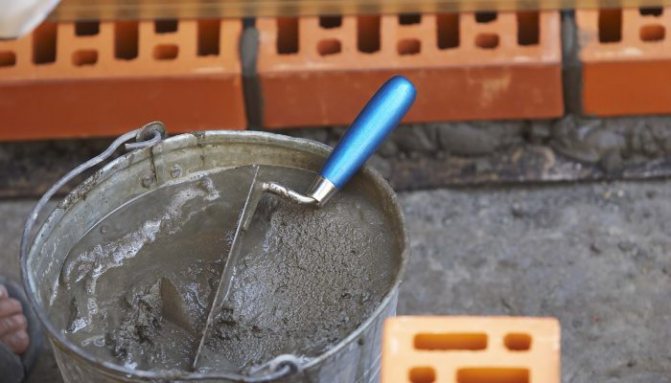

Liquid and clay are mixed into a homogeneous mass. Sand is added at the rate of: 1 liter capacity per bucket of water. The material must be checked for ductility. If the density is insufficient, sand is required.
The strength of the composition can be increased with cement or rock salt. Recommended proportions: 1 bucket of composition requires 1 liter of cement or 250 g of salt. The cement powder must be diluted with water, and the rock salt must be dissolved in water. After that, the additives are included in the mixture.
Masonry mortar is prepared in a strict ratio of components. During preparation, several recommendations are taken into account that affect the characteristics of the future mixture:
- The solution is brought to the consistency of thick sour cream. You can check the quality of the mixture by putting 1-2 bricks. If the joints of the kiln masonry are not completely filled with mortar, thin clay is used, which is not able to provide the necessary strength. It is necessary to enrich the solution.
- Craftsmen do not rely solely on the specified mixing ratios. Clay testing is mandatory.
- Solution additives are rarely used. Basically, additives and plasticizers are used if it is necessary to ensure frost resistance or hydrophobicity of the joint. When laying a red brick stove, it is better to use a sand-clay mortar. For fireclay, pure clay is suitable.
- Masonry mortar for stoves must not be used at temperatures below 5-8 ° C. Prepare the mixture without adding additives, it is recommended up to 15 ° C.
As already mentioned in the article, you will need to make a water seal to prepare clay. The material is kept in water and constantly stirred for 2-3 days. Before starting work, you will need to thoroughly knead the clay.
The sequential production of the mixture is as follows:
- Sifted clay is poured into the container, in a layer 15-20 cm thick, closed with water. Mix thoroughly every 24 hours.
- Sand is added to the finished solution, depending on the fat content of the composition.
- If a solution with liquid glass is needed, then the additive is poured into a working container immediately before laying.
We suggest that you familiarize yourself with: How to make a stove in a bath from a cylinder
Stir the clay with a mixer nozzle, a shovel or a construction trowel. The finished mixture is kneaded with a mixer until a homogeneous consistency.


After mixing, the solution is left to sour for 7-20 minutes. After that, mix the mixture again and get to work.
Preparation of a mortar for laying furnaces using refractory clay, after mixing with a mixer, will require letting the composition brew for an hour, which the manufacturer must indicate on the packaging.
During the preparation of the clay, the quality of the material must be determined. An exclusively normal composition is suitable for masonry. Oily and skinny clay, do not apply.
Masonry mortar is tested as follows:
- Time of harvesting - the fat content of the clay directly depends on the depth of occurrence. The deeper the loot, the leaner the composition will be. Checking is done by touch. A small piece of material is soaked with water until it resembles plasticine. If, after adding water, the composition crumbles, the clay is skinny, it is better not to use it.
- At home - half a liter of dry clay and 100-150 ml of water are taken for the test. After mixing the composition, two identical balls are molded from the resulting mass, one of which is flattened into a cake. The workpieces are dried within 2-3 days. After drying, the quality of the clay is checked. Look for visible defects. The reason for the cracking of the masonry mortar is high fat content, you will need to dilute the mixture with dry sand. A ball of clay mixture of sufficient density, should not break when dropped from a height of one meter.
It is better to knead chamotte clay without sand. A pure composition retains heat better, does not deform or crack. If it is necessary to reduce the fat content, chamotte sand is used when mixing, which does not reduce the quality of the solution.
Clay preparation is a laborious and complex process that can significantly save money during the laying of the stove. The use of ready-made factory compositions is expensive, but it is easy to prepare and has excellent masonry characteristics.
Clay components of mortars for brick heaters
One or another type of clay oven mixture purchased in a store is prepared according to the instructions on the package, there are no questions here.
If it is decided to use a home-made mortar for laying the stove, then the main conditions on which the quality of the mixture preparation depends are two - the correct preparation of the components and the observance of the proportions of the components.
Using the example of a clay-sand mortar, we will consider the preliminary operations and mixing rules.


Using the data in this table as a basis, you can achieve high quality masonry mortar by slightly adjusting the proportions with reference to the parameters of the components used.
The natural clay prepared for the stove must be cleaned of foreign impurities - everything foreign (plant remains, stones, debris) is manually removed, and large lumps are broken. Then the mass is rubbed through a metal mesh with a mesh size of approximately 3 mm.
We suggest that you familiarize yourself with: Mortar for laying a brick oven: proportions and how to prepare
Such "dry punching" is a laborious procedure, therefore it is more rational to pre-soak the manually cleaned clay for 2-3 days in a tin trough - lay in layers of 12-15 cm, wetting them abundantly, then cover the entire bookmark with water (approximate ratio: 1 part of water per 4 parts clay). After 2 days, mix thoroughly with your feet or with a mixer and rub through a sieve with a mesh of 2-2.5 mm.
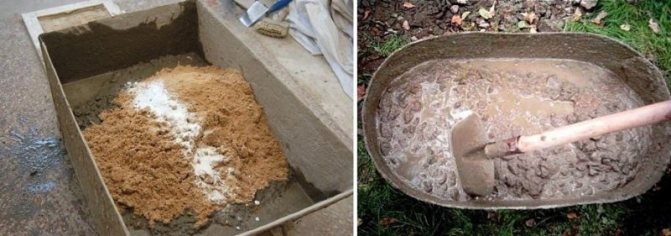

Ways to soak clay
Sand is prepared during soaking. Fireclay sand does not require preparation, except that it is sieved if purchased in bulk. And river sand must be sifted through a sieve with a mesh of 1-1.5 mm, then rinsed with running water in a container until the turbidity disappears and laid out on a clean inclined plane in order to remove moisture residues as much as possible.
There is no strict ratio of the volumes of these components, since any clay initially contains some amount of sand. Therefore, the proportion can be from 1: 2 to 1: 5, ideally the clay should only fill the voids in the solution between the grains of sand.
In order to have an approximate idea of the volumetric ratio of the components, the bucket is filled 1/3 part with a clay suspension when it is ready, and then sand is poured along the edge. The materials are thoroughly mixed in any container to the desired consistency with the addition of the required amount of water. The readiness of the mixture for laying the furnace is checked as follows - it should be held on the trowel after turning its plane by 1800 and slide off it when it is in a vertical position.
Testing the readiness of clay-sand mortar
If the mixture falls from inverted to 180
base, then you need to add clay to it. If the solution does not slide off the vertical plane, add sand. After correction, the check is repeated.
Having tested the solution in this way, an approximate volumetric ratio of the components is obtained.
Clay-sand mortar is used in furnace zones with temperatures up to 1000 0C. Full or partial replacement of river sand with chamotte sand allows you to use the mixture for laying a furnace with an operating temperature of up to 1800 0С, including in places of direct contact with a flame.


Variants of the classic style of stone ovens
Clay-sand mortar
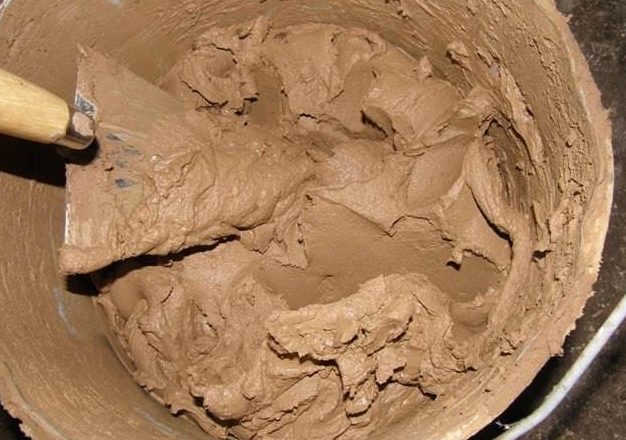

Used for guardianship, indoor chimney, fluff. You can also lay out a crucible on this if the oven is low or medium temperature.
Benefits:
- The material is inexpensive, in some cases it can be obtained for free;
- Environmentally friendly;
- Heat-resistant and heat-resistant;
- Plastic.
Cons - long preparation of materials for operation, use in low or medium heat ovens or only in the "body" of the oven, excluding the firebox.
Choosing sand
You can buy sand at a hardware store or get it yourself. It is necessary to use a river (alluvial) or quarry (medium-grained), cleaned of dust and debris using the method of sifting through a sieve, with a hole diameter of at least 1.5 mm. However, even sieving often does not save from the presence of impurities that deteriorate the quality of the future solution, therefore, additional processing is required.
For this:
- Use a tube that is about 2 cm in diameter and 6 cm long. You can also use a regular plastic beverage bottle.
- A hose is supplied to the bottom of the pipe, and the cavity is filled with sand by about a third.
- Provide a water supply through the hose so that the sand does not wash out, and dirty water with floating impurities overflows over the edges of the tube or bottle.
- The procedure lasts until the water is almost transparent.
- The sand must be dried by laying it out on a clean film.
Choosing clay
Clay is a material composed of the mineral kaolinite. You can get it on your own site or ask any of the local residents who recently dug a hole for any purpose.
You can also buy regular clay at the store. It is sold packaged in hermetically sealed bags. However, this does not mean at all that it can be immediately used in masonry. Before that, be sure to sift it through a sieve and determine the fat content in the following way.
The upper layer of clayey deposits is usually mixed with earth and other undesirable impurities in the masonry with poor adhesion. The optimal choice is considered to be a layer of clay deposits from a depth of 2-3 meters.
However, these are not all the selection criteria. Too skinny clay is crumbly, too oily will crack and shrink when dry. You can empirically determine whether the material is suitable for you.
- Roll 2 balls out of wet clay, about 5 cm in diameter.
- Crumple one in the form of a cake, and leave the other.
- Put the samples to dry in natural conditions, free from heat, wind and atmospheric precipitation.
- Examine them after 3 days. If cracks appear on the cake or ball, then the clay is oily and it is worth taking either another one, or depleting it by adding more sand when making the solution.
- The ball must be thrown to the floor from a height of 1 meter.If it crashes, there is a lot of organic matter and unnecessary impurities in the material. Ideally, it should completely retain its shape.
Mix the solution
Material proportions:
- Oily clay / sand - 1/2;
- Suitable clay / sand - 1/1.
It is believed that "skinny" clay can be used by reducing the amount of sand added to it. In practice, these actions are ineffective, it will not have good adhesion anyway.
The cooking procedure is as follows:
- To prepare the solution, pour the clay into a clean container and add a little clean water. Stir and leave to soak for 2 days, stirring occasionally.
- Wipe the solution through a 2-3 mm sieve.
- Add sand in the above proportion and stir. Pour water gradually, the consistency is standard - "thick sour cream". The solution is homogeneous, it should slide off the trowel smoothly, and not fall or stick.
Previously, salt was added to the mix for the masonry of the oven. This was done in order to drive out evil spirits from the hearth. Later, people forgot why they put salt, there was a widespread misconception that it increases the strength of the solution. In fact, except for efflorescence on the surface, which you will have to scrub off the brick every day for years, you will not get anything good from such experiments.
Proportions and mixing of the solution
You can not add sand to clay of medium fat content - it has the correct proportions of the components 1: 1
In addition to cleaning before mixing, the clay for laying the stove must be prepared. The material is laid out in a box or barrel upholstered with metal, filled with water so that the liquid covers it entirely. If there are large lumps, they need to be broken into smaller pieces in advance. Everything is mixed well and left for a couple of days.
The clay composition should be of a pasty consistency, without impurities. If, after 48 hours, small lumps are found in the mass, it must be mixed again, broken all seals and kept for another day.
After preparation, you can start preparing the solution. If clay is mixed with sand, the latter is poured into a prepared container, then plastic material is laid out, and a sand layer is again poured over it. A shovel is used to mix the components. If moisture appears at the top, add a little sand. Topping up with water is required in an overly dry composition. The solution can be considered ready if it slowly slides off the shovel and becomes uniform.
If the base is medium fat, you do not need to add the sand component. Step-by-step instructions for breeding clay without sand for the stove with your own hands:
- The material is laid out on a wooden platform in layers, each layer is moistened.
- Upon reaching a height of 30–35 cm, the mass is mixed. For this purpose, you need to spank the upper layer with the back of the shovel.
- The kneading continues until a homogeneous substance is formed.
You can check whether the masonry clay for the stove has been prepared correctly as follows: apply a thin layer on the red brick, put another block on top and leave it for an hour or two. If, when lifting the upper brick, the lower one does not fall off, you can use the composition for the construction of the stove. The clay sets for a long time, you can immediately mix the required amount of binder. It will take about 20 liters to lay out a 50-brick stove for a bath, and to build a Russian stove 15-20 percent more.
Failure to comply with the proportions of the components of the solution lead to cracking of the structure
How to dilute clay for oven putty:
- The dry base is ground and soaked.
- Sand with lime or cement is introduced. Proportions of medium-fat clay with sand and lime 1: 2: 1. When including cement powder, you need to proceed from the amount of sand component in a ratio of 1: 3.
- To make the plaster layer stronger, you can add asbestos, fiberglass, hemp or straw in a ratio of 1: 2: 0.1 (clay / sand / additives).
When additional ingredients are included in the clay solution, they are first mixed with each other, and only then with the previously soaked clay.
The plasticity and fat content of the masonry mortar are regulated by the addition of sand. You can determine the proportions as follows:
- Take a little clay and distribute it into 5 equal parts, of which we put sand in 4 portions in the amount of 1/4, 1/2, 1 and 1.5, and leave one without sand. After adding water, we knead each separately. The resulting blanks must be plastic and not stick to your hands. Flat pancakes are formed from them and dried. The quality of the mass is determined in this way: if the workpiece crumbles, then there is more sand than necessary, and the presence of cracks indicates its lack. It is optimal if the sample remains without cracks and is homogeneous.
Good mortar does not crack after drying
- You can do it easier: moisten a spatula in water and lower it into a clay solution - if the batch does not stick and the trowel gets almost clean, then the solution is suitable for masonry. In case of sticking, add sand, the clay is oily.
- Leave the clay solution alone. If after some time he pushes water to the surface - the clay is skinny, you need to add more of it to the batch.
- Dilute a bucket of clay with water until it becomes sour cream. Dip a wooden stick into it and determine the thickness of the adhered layer: if 1 mm and insignificant plasticity, you need to add clay, if the layer is thick and too plastic, gradually add sand (1 liter per bucket). It is necessary to achieve normal fat content, that is, the adhesion of a layer of 2 mm and individual clots.
Having determined experimentally the necessary proportion of the ratio of sand and clay in the future solution, we proceed to the preparation of the basic materials.
Main components
Used for furnace foundations that are not exposed to heat. Cement and sand are taken in a proportion depending on the brand of binder: M400 - 1: 4; M500 - 1: 5. The dry ingredients are sieved and mixed with water. The viscosity is checked by the degree of adhesion to a wooden oar or a shovel handle. It hardens quickly, therefore, the batch must be prepared immediately before work.
The composition of complex solutions depends on the place of their application. To protect the foundation and the street part of the chimney from moisture, you can make a cement-lime mixture, for the main body of the furnace - a cement-clay mixture. They will increase the strength and water resistance of the masonry.
The preparation of a multicomponent mortar is reduced to mixing one part of cement, three portions of lime dough and 5 to 15 sand. Kneading is done with a shovel or mixer. First, a conventional lime mortar is prepared, then cement is added and water is added. In another way, dry ingredients are mixed and poured into the diluted dough. It must be used within 45 minutes, otherwise it will lose its plasticity.
https://www.youtube.com/watch?v=78fqp8T0NoM
It is not difficult to make a high-quality mortar for stove masonry yourself if:
Tags: bath, clay, stove
«Previous post
Cement mix
A simple grout is mixed from sand, cement and water. The proportion depends on the brand of cement. Before adding water, cement and sand are thoroughly mixed together.
Adding additional ingredients creates a complex mixture. Often, the cement mortar is supplemented with the addition of lime paste. But then you need to use it quickly enough.In the composition of the solution, 1-3 parts of other binders and 6-15 parts of sand are laid on one part of the cement.
A heat-resistant cement slurry is obtained by adding Portland cement and fine broken bricks to a simple cement-sandy mortar.


